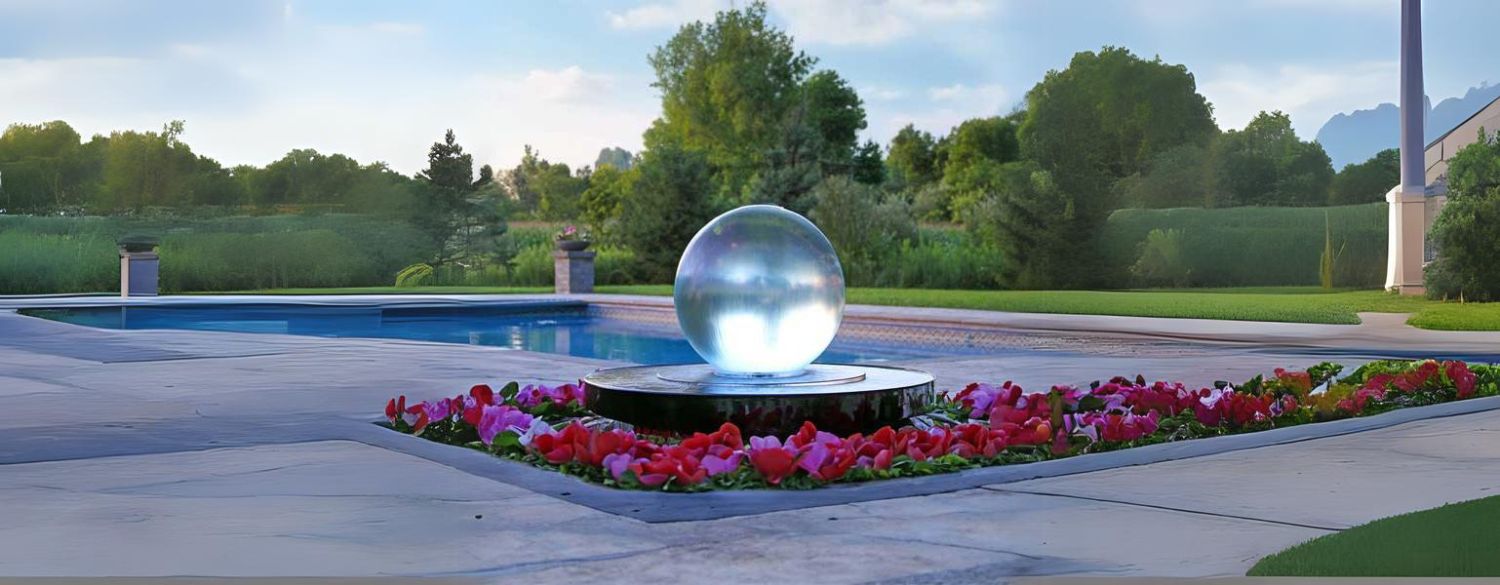
How Do Outdoor Fountains Work?
Curious about how outdoor fountains work? It’s actually quite simple. A pump moves water from the basin to the top of the fountain, where it’s released through a spout. The water can cascade down multiple tiers, stream from one or more spouts, or even bubble upright. Some fountains also feature plumbed spacers which allow water to flow from different points on the fountain in addition to the top. This continuous flow creates a soothing, relaxing ambiance in your outdoor space.

Most outdoor water fountains are designed to be simple and easy to install, without the need for a direct water supply or complicated plumbing. Fountains generally fall into these main categories:
- Recirculating fountains: These fountains use a pump to continuously move the same water in a closed loop, powered by electricity. Once the fountain is filled, the water circulates without needing a constant connection to a water source, making installation simpler and more cost-effective.
- Plumbed-in fountains: While these fountains also use a pump and are powered by electricity, they are connected to a direct water supply. Fresh water flows in as needed, making them ideal for larger or more elaborate setups. However, this option requires plumbing, which can make installation more involved.
- Solar-powered fountains: These fountains use solar panels to power the pump, making them energy-efficient and eco-friendly. They also recirculate water in a closed-loop system, but they function best in sunny locations where they can collect sufficient solar energy. They can’t be used in the evenings unless the fountain also has battery back up power.
- Battery-Operated Fountains: These fountains use a rechargeable battery to power the pump, allowing you the freedom to place them anywhere without needing a power outlet. They also reuse the same water in a closed loop system once the fountain is filled. The battery does need periodic recharging to keep the fountain running smoothly.
Recirculating fountains are more common due to their ease of installation and lower maintenance. However, it is helpful to place your fountain where you have easy access to a water supply to refill the fountain when necessary.
Splashing, water evaporation, and wind cause the water level in outdoor fountains to drop, requiring water refills to ensure the fountain runs smoothly. If you're looking for something more hands-off, some fountains are compatible with auto-refill devices. These devices will automatically refill the fountain to its optimal level and eliminate the need for manual refills.
Discover How Fountains Keep Water Flowing

At the core of every outdoor water fountain is a simple yet effective system that keeps water circulating continuously, allowing you to enjoy its calming effects. While backyard water features consist of several parts, they generally rely on four key elements:
The Water Pump
The water pump is the heart of the system and moves water from the reservoir or basin through the tubing, up to the spouts or head, where it flows back into the basin.
When choosing a pump for your fountain, consider five factors: size, gallons per hour (GPH), flow rate, power source, and cord length.
- Size: The pump’s size should match the fountain’s design. Larger fountains need more powerful pumps to move water effectively, while smaller fountains require less power to avoid excessive splashing or noise.
- Gallons per Hour (GPH): The GPH rating indicates how much water the pump can circulate per hour. Choose a pump with the right GPH for your fountain’s size and flow requirements.
- Flow Rate Adjustment: Opt for a pump that comes with an adjustable flow rate or valve that allows you to control the water flow to your desired level, ensuring the fountain’s appearance and sound match your preferences.
- Power Source: Select a plug-in electric pump for reliable, consistent power, or consider a solar-powered option for an eco-friendly alternative. Since some fountains may require more power than solar options can provide, make sure that the fountain you choose is compatible with your preferred power source.
- Cord Length: The pump’s cord length affects where you can place the fountain, as it must reach a power source. Shorter cords can limit your options, so always check the cord length to ensure it aligns with your intended placement.
Tubing, Piping, and Valves
The tubing and pipes act as the fountain’s circulatory system, directing water from the pump to the head or spouts. Typically hidden within the fountain’s structure, the tubing ensures a smooth flow. In some designs, valves allow you to adjust water flow and pressure, impacting how the water is released. Most pumps come with adjustable valves or dials to give you control over the flow rate.
The Head or Spouts
This is where the magic happens. The head or spouts release the water in a pattern that shapes the fountain’s sound and visual appeal. While the pump determines the water's overall speed, the nozzle design at the head influences the flow direction, whether it’s a gentle trickle or a powerful stream, creating the aesthetic and ambiance of your outdoor space.
The Reservoir or Basin
The reservoir or basin is often the most prominent part of the fountain, second only to the spouts. It holds the water for circulation and can be either above or below ground, depending on the fountain’s design. It’s where the water collects before being recycled back through the system.
Fountains featuring an underground basin are often called "disappearing fountains," like the one below by Blue Thumb. Surrounding pebbles elegantly conceal the hidden reservoir, where water is captured and recirculated up through each of the fountain columns.

Now that we’ve covered the key components that drive the fountain’s water flow, it's important to consider what powers this system. Whether you choose a hardwired, plug-in, solar-powered, or battery-operated fountain, your power source plays a crucial role in both performance and efficiency. Let’s explore the different power options to find the best fit for your outdoor space.
Key Power Sources for Outdoor Fountains
Outdoor fountains depend on a pump to keep water circulating smoothly, and the right power source is what keeps everything running efficiently.
Selecting the best power option ensures reliable performance, energy efficiency, and safety. Whether you’re looking for a simple plug-and-play solution or a more eco-friendly option, understanding your power choices is key to maintaining the beauty and functionality of your fountain.
Electric Power
Hardwired Fountains
- Hardwired fountains offer a permanent solution, with a direct connection to your home’s electrical system. This setup provides a constant stream of electricity, making it particularly useful for larger or more intricate water features that require additional power. Professional installation by a licensed electrician is essential to ensure safety and proper functionality, allowing these stunning fountains to beautifully enhance your outdoor space.
Plug-In Fountains
- Plug-in fountains are a common choice for outdoor water features. These fountains connect directly to a standard electrical GFCI outlet, providing a reliable and consistent power source. Their straightforward installation allows you to enjoy the soothing sound of flowing water without hassle.

Solar Power
Solar-Powered Fountains
Solar-powered fountains are an eco-friendly choice that harness solar panels to convert sunlight into energy for the pump. This green energy not only reduces reliance on traditional electricity but also simplifies installation by eliminating wiring. Just remember, their performance may dip on cloudy days or in shaded areas. To ensure consistent operation, many homeowners pair solar panels with a hardwired backup system. It’s a wonderful way to enjoy the beauty of water features while being kind to the planet!

Battery Power
Battery-Powered Fountains
These fountains offer flexibility and convenience by operating on a battery, and in some cases, even multiple batteries, allowing for easy placement without the need for direct power. Ideal for smaller water features, these fountains are portable and simple to install, making them a great choice for various outdoor settings. However, it's important to note that battery life can limit their operational time. You’ll have to recharge the battery or batteries when necessary to keep the fountain running smoothly.

Does Design Affect How a Fountain Works?
The design of an outdoor fountain plays a role in how it operates, affecting everything from water flow to basin size and pump type. By understanding these elements, you can choose the right fountain for your space and ensure it performs at its best. Let’s explore the key factors influenced by a fountain’s design.
Water Flow Rate
The shape and height of a fountain directly affect the speed and force of the water flow. For example, a tall and narrow fountain with a single spout will produce a concentrated, faster stream, while a wider, multi-tiered fountain disperses the water more evenly, creating a gentler, cascading effect as it flows over each tier.
Splashing and Water Containment
Fountains with multiple tiers or steep drops tend to create more splashing, which can affect the surrounding area. To avoid water overflow, splash guards or strategic placement are often essential.
Basin Size and Shape
The design dictates the capacity of the bowls and basins, influencing how much water they hold and how frequently they require refilling.
Pump Type and Location
Certain designs may necessitate specific types of pumps (submersible vs. external) or dictate where the pump can be placed for optimal function.
Energy Efficiency
The design can impact how efficiently the fountain uses energy, particularly if it relies on solar power or requires a more powerful electric pump.
Aesthetic Appeal
The visual design affects how the fountain complements its surroundings, influencing the overall ambiance and how it interacts with nearby plants, pathways, and outdoor features.
Sound Quality
The design of a fountain affects the type and intensity of water sounds, from a soft trickle to a dynamic cascade. These sound variations set the tone for your space, offering either a tranquil retreat or a lively atmosphere.
Maintenance Needs
Complex designs with more components (like multiple tiers or intricate details) may require more frequent cleaning and maintenance compared to simpler designs.
Final Thoughts
Outdoor fountains are a stunning addition to any outdoor setting. Understanding how they work empowers you to choose the perfect fountain that complements your style and meets your functional needs. With insights into the mechanics of water flow and the impact of design, you can ensure your fountain operates efficiently and enhances your space. This knowledge not only helps you create a serene and inviting atmosphere in your garden or patio but also transforms it into a delightful retreat for relaxation and enjoyment.
If you have any questions about how outdoor fountains work—whether it’s about water flow, pump maintenance, or troubleshooting—we’d love to help! Our team is passionate about fountains and truly enjoys connecting with fellow fountain lovers. Please feel free to give us a call at 1-800-975-4022 ext. 3 or drop us an email at support@theblissfulplace.com. We can’t wait to hear from you and help in any way we can!



Leave a comment